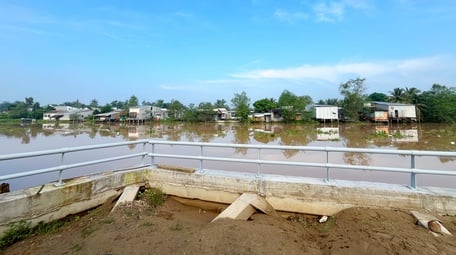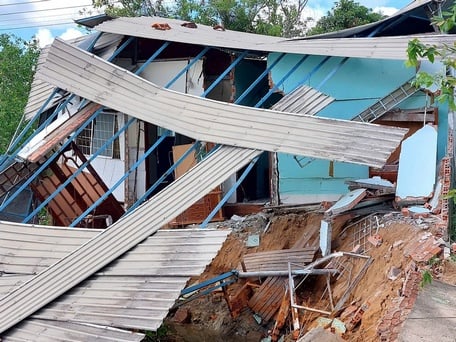Landslides often leave serious economic consequences, directly affecting people's lives. The question is why do landslides occur and are occurring more frequently than before and why is it difficult for us to predict and prevent this type of natural disaster?
 |
| The habit of building houses on rivers has many potential risks of landslides. |
After reinforcement, landslides continued.
On October 26, 2024, a landslide occurred on the bank of the Co Chien River in An Hoa Hamlet (An Binh Commune, Long Ho District). This landslide was about 90m long and 3.5m wide, at the beginning of Ms. Nguyen Ngoc Yen's land; affecting about 100 households and about 70 hectares of fruit gardens; 1 low-voltage power pole fell and dragged about 80m of unsafe low-voltage power lines.
Previously, in August 2024, on the same coastline, a landslide occurred 100m long and about 3.5m deep at the end of Ms. Nguyen Ngoc Yen's land and Mr. Nguyen Dinh Luy's land. The landslide had just been reinforced and repaired by the local authorities, but now another landslide has occurred in the adjacent section.
Immediately after the landslide, the People's Committee of An Binh commune came to survey the scene, supported people to relocate their property, and reinforced the dike to avoid damage to people. The cause of the landslide was initially assessed as being due to the flood, high tide, fluctuating river water level, and soft ground, causing subsidence and landslides. Forecast: the possibility of subsidence and landslides will continue to occur.
According to the authorities, first of all, due to urban land pressure, people live very close to the riverbank, increasing the load on the riverbank, creating conditions for landslides to occur. Second, most of these areas have very weak soil, even in many places there is very little soil, and people only pour sand on it to level and build. Along with that, due to natural conditions, the transition between the dry and rainy seasons, plus the flow and tidal factors have contributed to increasing the risk of landslides.
At the serious landslide point in Tich Loc hamlet (Tich Thien commune, Tra On district), the cause is due to the deep riverbed, under the impact of waves due to the flow and high density of waterway traffic, the riverbank is severely eroded, combined with the load of houses built along the riverbank, when the river water level is low, the riverbank becomes unstable, easily causing landslides.
Mr. Ho Phuoc Du - Head of the Department of Agriculture and Rural Development of Mang Thit district said: most of the landslides were determined to be due to soft soil, heavy rain, loose riverside soil; the river has many curved sections, fast flow, close to the shore creating frog jaws, erosion causing landslides. In addition, the exploitation of river sand reduces the alluvial content in the flow, large rivers lower the channel. Watercraft such as ships, barges circulating and anchoring create waves causing surface erosion, propellers cause flow disturbances breaking the structure of the riverbed.
According to Mr. Dang Minh Quan - Vice Chairman of Vinh Long City People's Committee, landslides and subsidence on inter-traffic routes and dikes and embankments along large rivers still occur, especially during peak tides. The increasingly complex weather has made it difficult to respond and prevent. Some localities have not been proactive in maintaining and repairing disaster response works, and are still waiting for investment and support from higher levels. There are cases where works have deteriorated and collapsed but have been slow to repair, leading to increasingly serious landslides and subsidence.
| Assoc.Prof.Dr. Le Anh Tuan - Institute of Climate Change Research (Can Tho University): With the current situation, landslides in the Mekong Delta may continue for decades to come due to the decreasing amount of alluvium from the Mekong River, along with excessive exploitation of sand and groundwater. When there is a lack of alluvium, the river becomes deeper and the riverbanks become steeper, leading to sliding and landslides to compensate. The Tien and Hau rivers - the two main rivers in the Mekong Delta - now have deeper beds than before, so the beds must be withdrawn from the tributaries to compensate. The tributaries continue to withdraw the beds of their branches, causing landslides to spread everywhere, even to the rivers and canals in the fields. This explains why landslides in the Mekong Delta are now not only on the main rivers as before but also appear throughout the region, most seriously on the islands due to weak soil. |
Impact from nature and humans
Mr. Van Huu Hue - Deputy Director of the Department of Agriculture and Rural Development said that the cause of landslides comes from different impacts, from nature and from humans. Specifically, from nature: soft geology; heavy rain; irregular semi-diurnal tides (2 high tides, 2 low tides/day) reduce the adhesion of riverside soil, riverside soil is "loose" and not tightly connected, causing landslides. Along with that, the curved river morphology, the mainstream current close to the bank, attacking the bank causing landslides. At the same time, the emergence of sandbars changes the flow...
Regarding human factors, sand mining has reduced the silt content in the flow, large rivers have lowered their channels, causing tributaries to lower their channels as well. In addition, there are heavy loads along the river. That is, river encroachment projects, fish rafts along the river reduce the wet cross-section, making the flow velocity increase. In addition, ships and barges passing and anchoring cause waves that cause surface erosion, propellers cause flow disturbances that break the structure of the river bed...
In addition, the flow dynamics affect the channel with a soft geological structure. At the same time, due to sand dunes emerging in the riverbed, the flow changes, pressing close to the bank, causing landslides. Landslides often occur in the areas of islands and where the river branches, the confluence areas of the river branches, sections of the river with unstable channels, where the river is narrow, bottlenecked and because the river is "starved" of alluvium.
Accordingly, lack of alluvium is one of the main reasons for the increasingly serious erosion. Currently, most of the alluvium is trapped in reservoirs upstream. "When the alluvium content is low, the water flow is lighter, has excess energy, flows strongly, swirls into the banks and riverbed, leading to erosion" - Mr. Van Huu Hue added.
It can be seen that riverbank erosion has become a type of natural disaster that causes serious consequences. However, solving this problem cannot be done in a short time. Therefore, to respond to and overcome the consequences of erosion, it requires functional sectors, localities and people to focus all their efforts on implementing structural and non-structural measures to minimize the damage caused by this type of natural disaster.
Regarding the basic causes of landslides, according to the Ministry of Agriculture and Rural Development, for the situation of landslides on river banks and canals, most landslide areas often occur strongly, commonly at the tops of curved river bends, the locations of the estuaries, the heads of islands, densely populated areas... The flow rate on the Tien River system is large, the Hau River, the curved river section, the estuaries are also larger than the Hau River, these are the locations that generate large and complex flow velocities. Therefore, the number of erosion points on the banks and riverbeds of the Tien River system occurs more, and the level is also larger than the Hau River.
 |
| Most of the landslide areas have very weak ground. |
River areas affected by both floods and tides (interference areas) often have very complex flow directions and velocities, especially at low tide when the flow velocity suddenly increases, causing great erosion of the riverbed and riverbanks (typically rivers in Vinh Long province). In addition, there are other causes from uncontrolled economic and social activities.
Faced with the increasingly serious situation of riverbank, canal and ditch erosion in the Mekong Delta in general and along the Tien and Hau rivers in particular, over the years a series of bank protection works have been built to reduce the damage caused by bank erosion. The structural forms of bank protection works are quite diverse and rich. According to basic statistics, there are 3 main types of bank protection works including folk and rudimentary works; semi-permanent works; and permanent works.
| Mr. Nguyen Thanh Can - Head of Economic - Budget Committee of Provincial People's Council: Illegal exploitation of mineral resources of soil and sand without planning also causes landslides of large and small rivers, soil and sand extraction near the shore. Construction solutions for some irrigation works, combined with irrigation works are not suitable, sometimes increasing landslides. For example: digging soil near the shore, taking soil too deep, causing the loss of the slope of the canal, causing landslides. Accordingly, the works done by the people themselves also cause landslides, the works implemented by the State also cause landslides. |
Article and photos: FRESH SPRING - THAO LY
>> Part 3: Promoting the effectiveness of engineering and non-engineering solutions
Source: https://baovinhlong.vn/tin-moi/202411/nghi-quyet-ung-pho-sat-lo-giam-thieu-rui-ro-thien-tai-ky-2-sat-lo-do-dau-va-vi-sao-3487a85/



























![[Photo] National Assembly Chairman Tran Thanh Man visits Vietnamese Heroic Mother Ta Thi Tran](https://vphoto.vietnam.vn/thumb/1200x675/vietnam/resource/IMAGE/2025/7/20/765c0bd057dd44ad83ab89fe0255b783)









































































Comment (0)